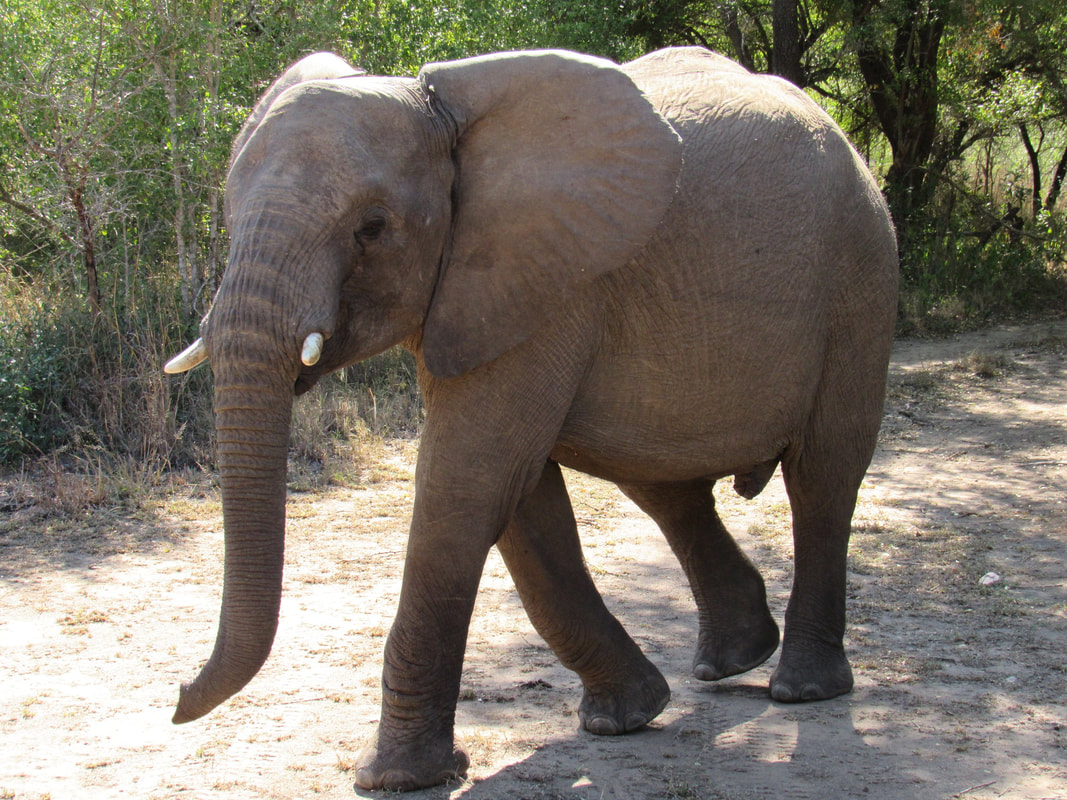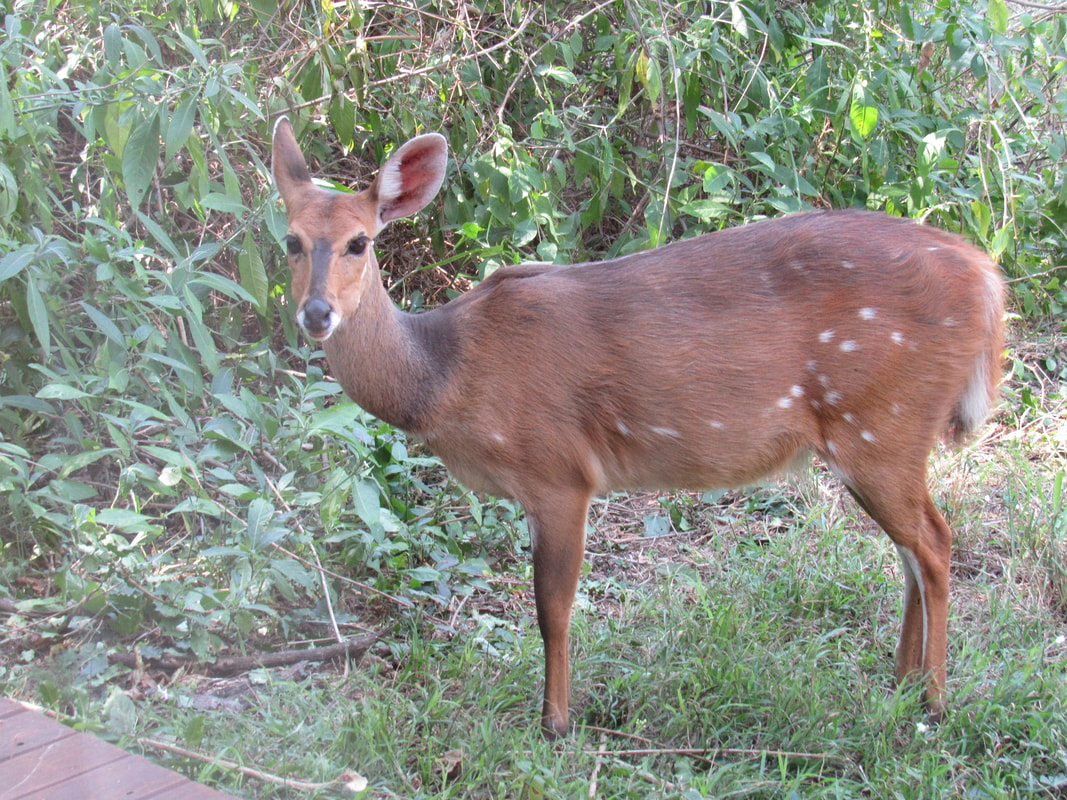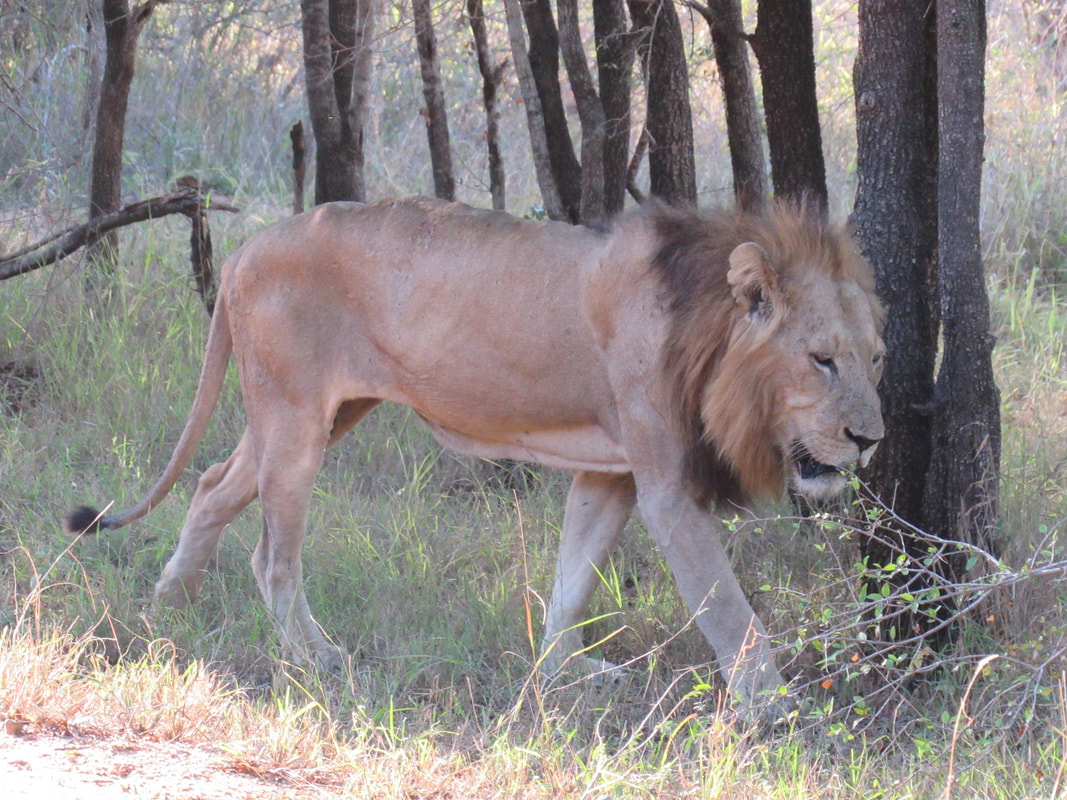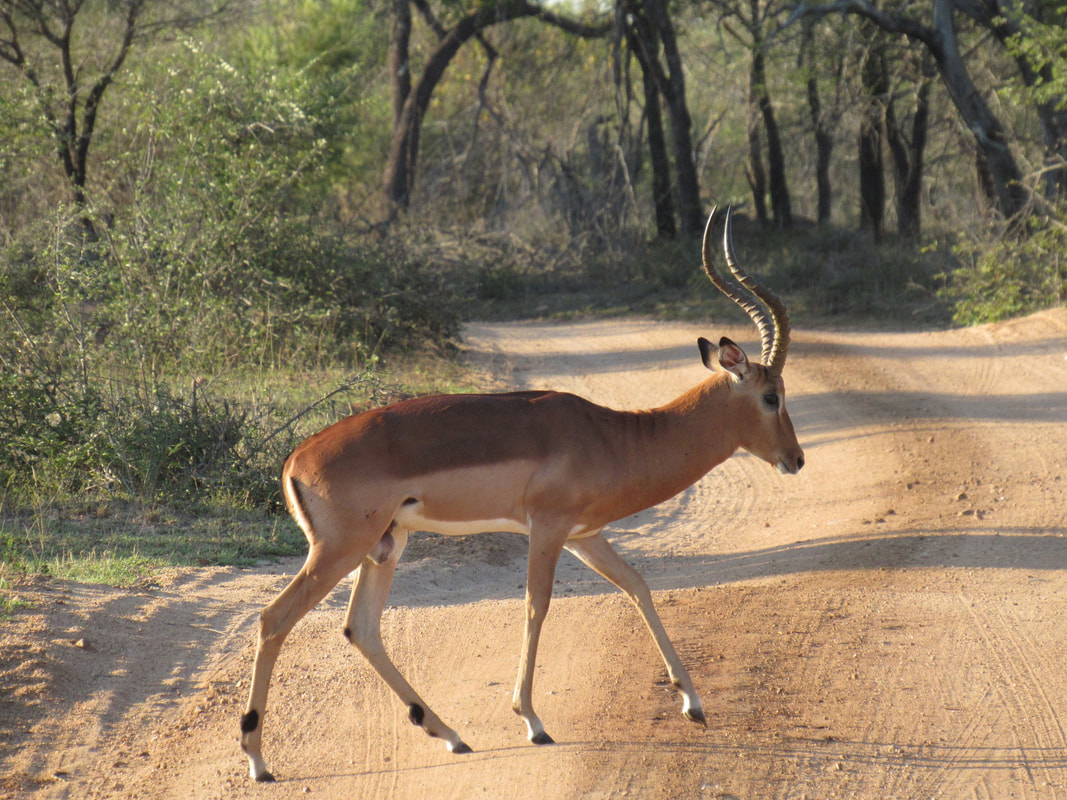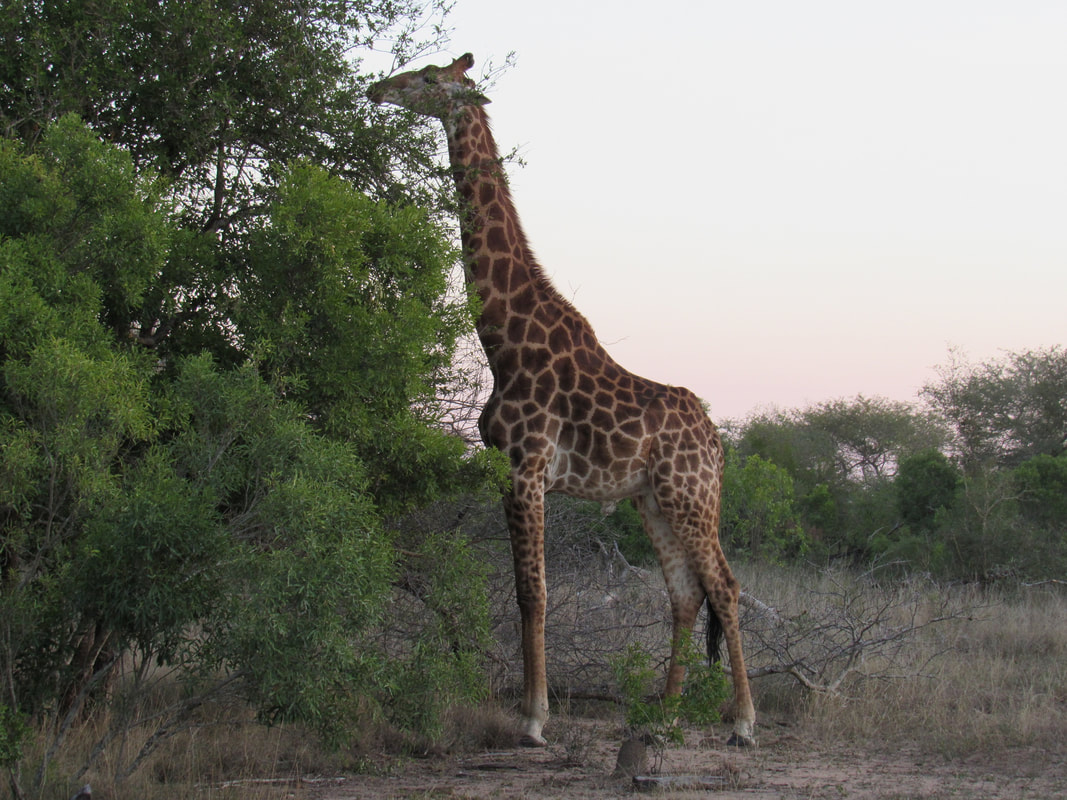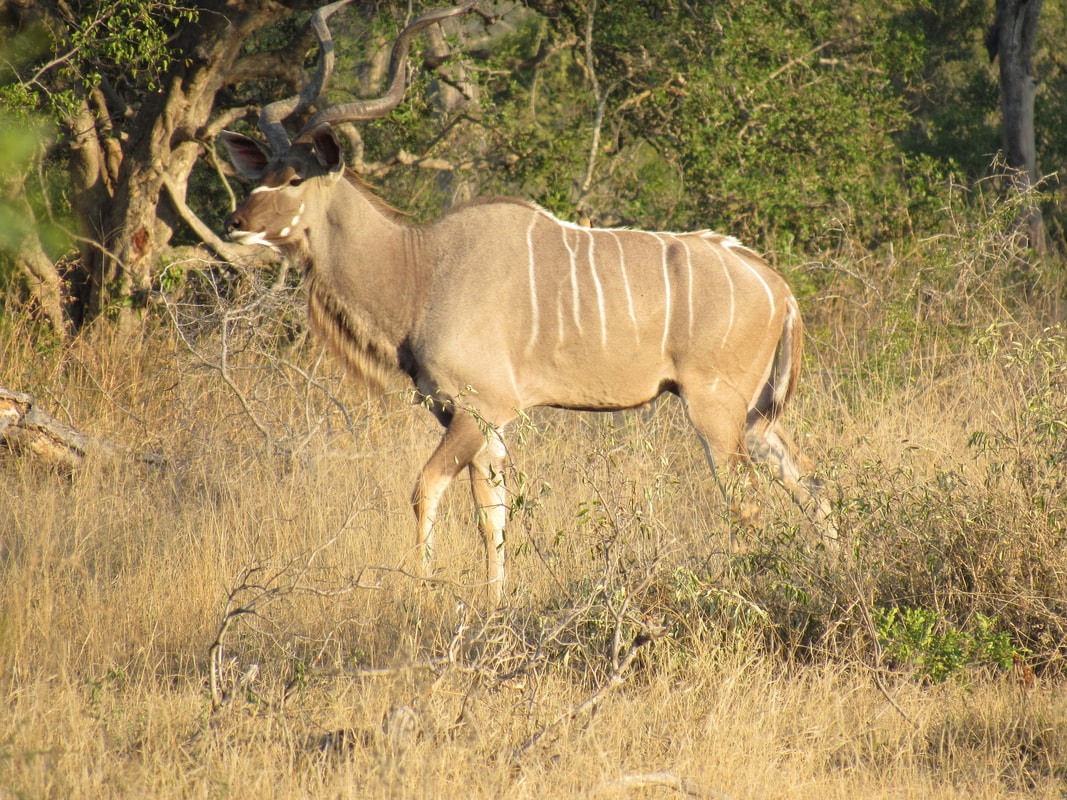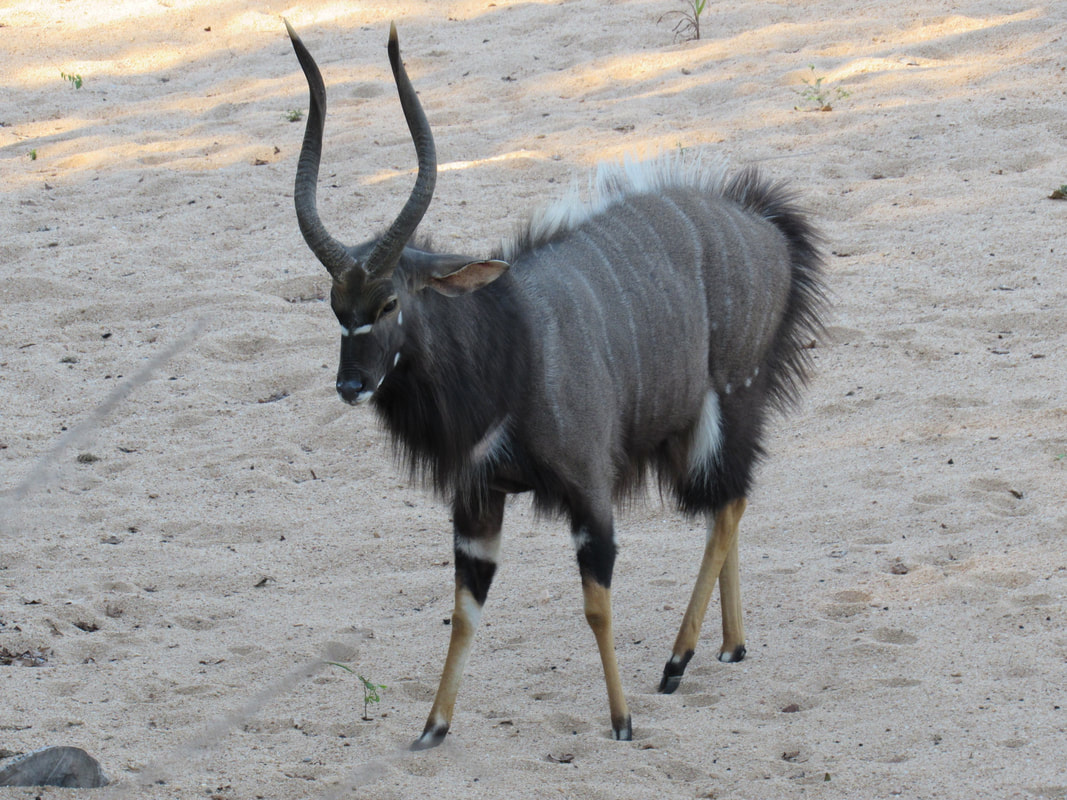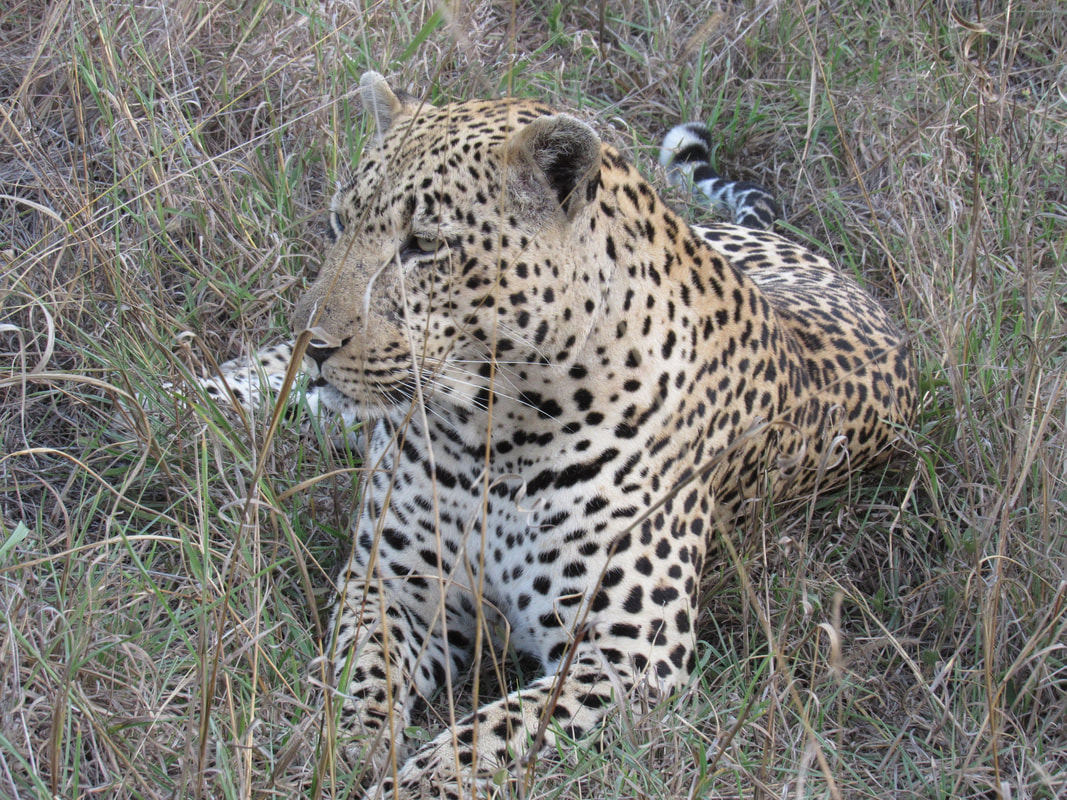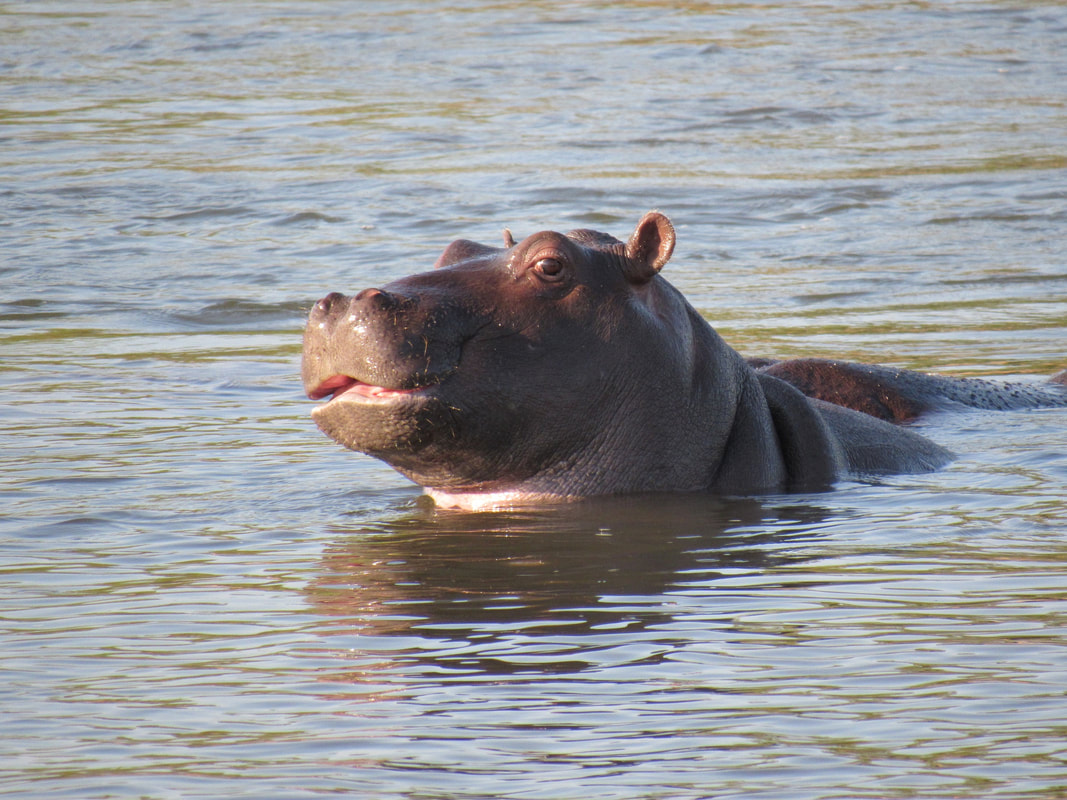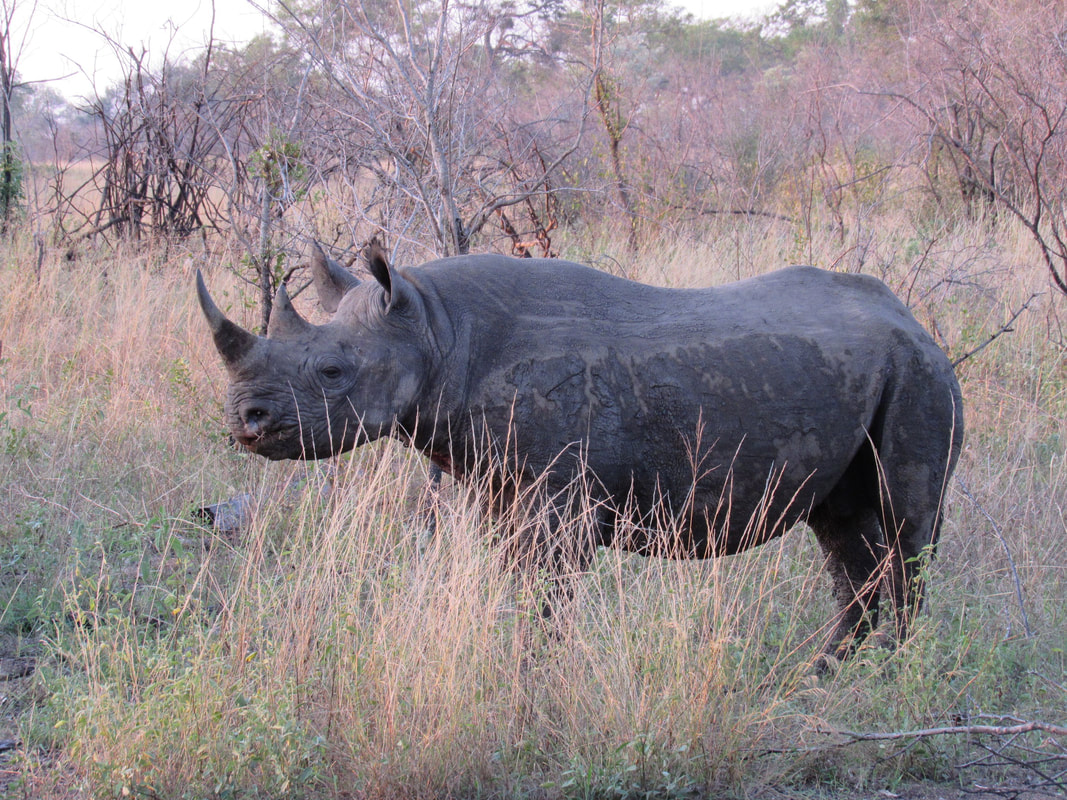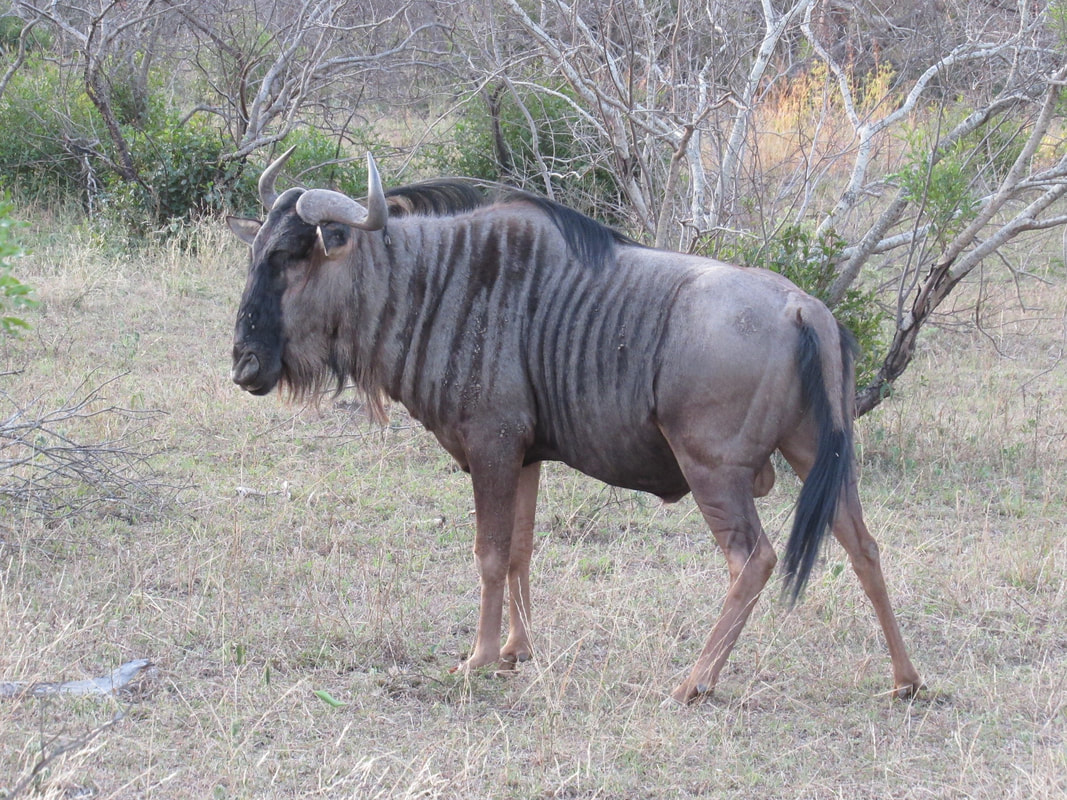|
Four Days in the South African Bush
Copyright © 2015 by Thomas Piccin Day 1: Thursday 5/14/2015 The 30-minute drive from Skukuza Airport to our safari lodge on the grounds of the Lion Sands Game Reserve, a private reserve adjacent to Kruger National Park in the northeast corner of South Africa, took us over bumpy dirt roads winding through wooded areas, across dry river beds, and over grassy plains. On this drive, in addition to herds of impalas, kudus, and other antelope species grazing peacefully, we also saw an African elephant, which would be the first of our sightings of the “Big Five.” This term, coined in the past by big game hunters, refers to the five most difficult and dangerous animals in Africa to hunt on foot. In addition to the elephant, the Big Five includes the lion, the rhinoceros, the leopard, and the African buffalo. When we arrived at the Lion Sands River Lodge, one of the first things we did was have lunch. From the outdoor dining area overlooking the banks of the Sabie River, we saw more impalas on the opposite side of the river, as well as springboks, vervet monkeys, and a giraffe. Bushbucks wandered freely through the camp, feeding on the vegetation that surrounded the cabins and the wooden walkways connecting all the buildings. They would not approach me or allow me to approach them, but they would let me sit within a few feet and watch them. Game drives took place twice per day, at 6am and 4pm, when the animals were most active. Since we had arrived in the early afternoon, our first game drive was that evening. My party of five boarded the open-air Land Rover, which had six passenger seats, arranged in three rows of two like stadium seats, with the highest seats in the back. All our game drives were led by our ranger Sydonea, assisted by our tracker Patrick. Syd drove the vehicle, and Patrick sat in the tracker’s seat mounted above the hood on the left side. We started down the dirt road leaving camp, but before we even got past the camp gate, we encountered two male lions walking unhurriedly toward us through the woods. “Lion,” Syd said calmly, pointing to the left and stopping the vehicle. The lions sauntered casually along the road, passed us within an arm’s reach, and continued into the woods on the other side of the road. They appeared surprisingly thin, almost emaciated, and one was badly scarred on its hindquarters. Syd told us later that these lions were two of three brothers that had separated from their pride, and the scars were from battles with other males. I was impressed by the calmness Syd and Patrick displayed when in such close proximity to these ferocious animals, but I was amazed at the indifference of the animals themselves. The lions barely glanced at us. They were clearly aware of our presence, but simply uninterested. There had been no legal hunting in this region for several generations, so the animals had no particular reason to fear humans. Prior to the drive, Syd had warned us to stay in the vehicle and not to stand up. As he explained it, the animals were accustomed to seeing the vehicles, but if we stood up, the animals might see us as individuals, and perceive us either as a threat or as prey. Over the next three hours, we saw a herd of African elephants, a white rhinoceros, a giraffe, several kudus, many impalas, half a dozen warthogs, some vultures, a pair of wild dogs, a spotted hyena, and a young leopard crouched in a tree. As we drove, Syd and Patrick looked to both sides of the vehicle for signs of animals, and also scanned the ground for fresh tracks and dung. Syd kept in radio contact with the other game drive vehicles, so if one sighted an animal, the other vehicles could come and have a look also. However, the lodge policy was that no more than two vehicles be in close proximity to an animal at any time. According to Syd, this was to avoid making the animals feel trapped or threatened, which could prompt them to flee. “The animals should always have an escape,” he explained, his voice deep and heavily accented. Presumably, an animal that felt threatened would also be more likely to attack.
Some animals were more skittish than others; Syd stopped the vehicle within ten feet of the rhinoceros to allow us to watch and take pictures, but we could not get within 200 feet of the warthogs before they scampered away. The elephants and the giraffe did not run away when we approached, but they kept a discrete distance and seemed to keep one eye on as us they ate. In fact, all the animals seemed to spend every waking hour eating. Except for the vultures and the big cats, every animal we would see over the four days we were on safari was eating constantly. Just as the sun was setting, after we had been driving for a couple of hours, Syd stopped the vehicle. We were delighted when he and Patrick unloaded several coolers from the rear of the vehicle and set up a full bar, complete with snacks, on the hood on the Land Rover. This was to be a regular event on every game drive. It was a chance to get out, walk around, and explore the landscape up close, never straying too far from the group. For the last 45 minutes of the drive, we were in complete darkness. The Milky Way was clear in the sky, as was the Southern Cross, a constellation not visible from the northern hemisphere. Patrick held a powerful floodlight that he swept from side to side as we drove. As we headed back to the lodge, we received a radio call that another group had found a leopard, and Syd drove to join them. When we arrived, all we could see was a circle of light high in the tree, as the tracker in the other vehicle aimed his floodlight at the cat. Syd told us that the young leopard was waiting for its mother to bring it food, as it was still too young to hunt for itself. The leopard was almost completely concealed by the leaves of the tree, so we could not get any good pictures of it. Nevertheless, we were excited by this sighting, as it was only our first game drive and we had already spotted four of the Big Five. Dinner back at the lodge was outdoors under the stars, the tables arranged around a campfire in the “boma,” a Swahili word that means gathering place. Since animals often roamed freely through the camp, the lodge rule was that no guests could walk to or from their cabin after dark without a staff member escort. As it happened, on this night there were elephants in the camp, and we had to keep our distance, for our safety as well as for that of the animals. Two of my party were unable to return to their cabin until after dinner, because the elephants had positioned themselves directly in front of their cabin door. Day 2: Friday 5/15/2015 The next morning’s wake-up call came at 5:20am, and by 6am we had had our coffee or tea and were on our way out of camp. The sign by the side of the road read “30 km/h – Animals Have Right of Way.” We first came across a group of elephants, including a baby elephant sleeping under a bush, his mother keeping a watchful eye from nearby. The elephant’s digestive system is inefficient, Syd explained, and the animal can only digest about 40% of what it eats. This means an elephant must eat a lot to get the nutrition it needs to survive. It also means there is a lot of edible material still remaining in an elephant’s dung, and Syd told us it is common for an elephant to eat another elephant’s dung, or even its own dung. We sat and watched the elephants for a while before moving on. Occasionally Syd would stop the vehicle, turn off the engine, and sit silently as he and Patrick scanned the horizon, listening and looking. At one point, the men thought they saw lion tracks, so they both got out and walked along the road looking for other signs. Syd carried the rifle that was usually mounted behind the driver’s seat, and Patrick had only the hunting knife he wore on his belt. After a few minutes both men returned to the vehicle, as apparently there were no lions to be found, and we continued our drive. Parts of the bush were open and flat with grass and short trees, while other areas were more thickly overgrown with trees and tall bushes. We soon passed a herd of giraffes, and when we got too close, they started to run. Their legs and necks were so long that they appeared to run in slow motion, as their heads bobbed gracefully up and down. We also saw many impalas, which would be the most frequently sighted animal during our visit. Nearby was a cluster of male kudus, with their large spiral horns and distinctive white vertical lines on their brown hides. A short time later, we had our first zebra sighting. We saw several zebras at the end of a distant road, but we did not approach them because they were within the boundaries of another game reserve. There are no fences separating the various private reserves from the national park reserve, and the animals roam freely from one reserve to the next. But on our drives, our ranger was careful to stay within the borders of our lodge’s private reserve. We took some long-distance pictures of the zebras and moved on. We spent most of the rest of the morning tracking a leopard without success. Having seen leopard tracks leading away from the road, Syd took the vehicle off road through some tall grass and into a wooded area.
One of the first things we had noticed about the Land Rover on our first game drive was that it had no seatbelts. Even Patrick, perched on his seat above the hood, had no seatbelt. While some of the roads through the African bush were well-defined through years of use, others were barely paths. Often, in order to follow animals or get closer to them, Syd would plow through the brush and trees where there was no road at all. As we bounced along over the rocky, uneven terrain, we did our best to hold on to our cameras and binoculars while staying in our seats, all the while dodging thorns and branches. On our first day, Syd had warned us to pack our cell phones away so we wouldn’t lose them on the drive. “I can track an elephant,” he had said with a wry grin, “but I cannot track a cell phone.” Syd brought the vehicle to a halt, and he and Patrick hopped down and disappeared in separate directions, looking for leopard tracks. We sat silently for almost 15 minutes, nervously watching and listening. Eventually Syd returned and we spent some time driving around, looking for Patrick. Periodically Syd would stop and give a short whistle or bird call. I couldn’t tell if he could hear a reply from Patrick or not. Syd was also using the radio to speak with other rangers who were tracking the leopard as well, but the rangers spoke Shangaan among themselves, so I couldn’t understand what was being said. Finally we met up with another group from our lodge, and I was relieved to see Patrick with them. After Patrick rejoined us, we stopped in a dry, sandy river bed for our morning coffee and tea break. We saw buffalo dung just a few feet away, but to that point we had seen no buffalo yet. As we stretched our legs, we heard the persistent call of the grey go-away bird, so named because its call sounds like the bird is shrieking “go away!” Finally, we headed back to the lodge for breakfast. On the way we saw several guinea fowl, each with its curious red and blue facial markings and a backward-curving horn on the top of its head. During breakfast we saw a hippopotamus in the river from our table, and when I returned to my cabin, I noticed there was elephant dung ten feet outside my back door. The elephants had been close by last night. The time between breakfast and lunch was our own, and on this day I used it to get a massage at the open-air spa hut at the far end of camp, adjacent to the river bank. Lunch was at 1pm, high tea was at 3:30pm, and then it was time for our evening game drive. By any measure, our evening game drive was a spectacular success. The first animal we encountered was a giraffe, off to the side of the road. As we approached and stopped the vehicle, the animal turned to face us, seemingly posing for a portrait. Over the course of our visit, we would have several giraffe sightings. Usually we saw them in groups, but sometimes, as in this case, we saw an individual grazing alone. Syd told us that giraffes have no vocal chords, so they do not make sounds that humans can hear. Instead, they communicate with each other using low frequency emissions. Next we came upon a group of six plains zebras, and we were able to approach within a few yards. Most were just grazing in the tall grass, but one found a bare spot and started rolling around in the dirt. After a minute it was back on its feet and trotting away. I was interested to see that the zebras had thin brown stripes between the thick black stripes. As we continued our drive, we saw more of the ever-present impalas, sometimes in large groups and sometimes just one or two individuals. We also saw more guinea fowl. Then we got a radio call from another group’s ranger, and we sped off to their location. They had found some buffalo. The African buffalo, also known as the Cape buffalo, is a massive animal. A bull can weigh close to a ton. As we approached, we saw several buffalo lounging near a water hole. Buffalo cannot store water internally, so they need access to water daily. The animal closest to me had enormous curved horns that appeared to extend at least a yard in each direction from the top of its head. We drove to within 15 feet of the animal and stopped. The buffalo eyed us warily but made no threatening moves. We sat for several minutes and watched it eat. We moved on, pleased that we had conquered the Big Five on only our second day. Near the water hole we saw some Egyptian geese and a grey heron, and as we passed through a dry river bed, we saw a lizard stretched out on a rock. Then we drove up the steep river bank, rounded a curve, and came face to face with a full-grown leopard walking toward us right down the middle of the road. To my eye, the leopard is the most beautiful of all the animals we would see in Africa. As this animal padded stealthily past us, I could see the light brown spots surrounded by black spots on its white coat. It paid little more attention to us than the lions had the night before, but at one point it did look directly at us as it passed, as though daring us to make a move. We made a U-turn and followed the leopard for quite a while, down the road and across a grassy plain. As it lie in the grass posing for us, another safari group joined us to watch as well. After a while, Syd started the engine and we drove on. We had barely driven half a kilometer when we rounded another curve and came upon a herd of elephants in the road. As we approached, they moved out of the road—surprisingly quickly, given their size—and as we passed, we came close to a baby elephant that was trailing behind the group. The mother turned in alarm, but we were already past. We stopped a short distance up the road to watch the herd. We spent a lot of time on these drives just sitting silently and watching the animals.
When we had seen enough of the elephants, we drove on. Soon we emerged from the woods to see another group’s vehicle parked in the road, and five lions sprawled out sleeping on the road in front of them. Syd recognized these lions; they were the two males we had seen on the first day, plus the third brother, a female, and a young male. As we watched, occasionally the lions would open their eyes, stretch, yawn, or roll over on their backs. But mostly they just lay on their sides, looking remarkably like house cats napping by a window. After we had stopped for our sunset happy hour, we headed back to the lodge in the darkness. With his floodlight Patrick was able to spot a flap-necked chameleon in a tree, and as he shined the light on it, the animal turned green and brown to blend in with the surrounding leaves. Further down the road we saw a giant eagle owl, and then another herd of giraffes. Patrick was careful not to shine his light directly at the giraffes. Syd explained that the light might temporarily blind the animals, and if they were to become frightened and run, they might stumble on a rock or tree and hurt themselves. Day 3: Saturday 5/16/2015 Our 6am game drive started out strong with sightings of many impalas, kudus, a tawny eagle, and three lions that we followed quite closely for a while. These were three of the lions we had seen sleeping the previous evening—a male, the female, and the young male, which Syd told us was about two years old. As we watched, the young lion played with its mother. At one point the young male jumped up onto a log, posing majestically for us. We continued on our drive and passed a dozen guinea fowl, five giraffes, and a nyala, which is a spiral-horned antelope with markings similar to those of a kudu. Near the giraffes were four zebras grazing close to the road. It was still chilly this morning, and as we watched the animals eat, we could see our breath. Syd started the engine and we continued our drive. After chatting briefly with another ranger on the radio, he took us down a long road into a wide open field where we saw another vehicle parked under a tree. In the tree was the leopard we had tracked yesterday. The other ranger told us that the lions we had seen earlier had chased the leopard up into the tree. “It is all about competition for food, yeah,” Syd explained. The leopard stayed in the tree for maybe 10 minutes, continually scanning the horizon, before deciding to leap back to the ground to continue his search for breakfast. We followed the leopard as it walked calmly across the field toward a herd of impalas. The impalas did not run away; instead, they maintained a constant distance from the cat, their eyes fixed on the threat, repeatedly emitting an alarm call that sounded like a short, deep growl. The leopard stalked them for several minutes but did not make any attempt to attack. At the very top of a nearby tree, two African white-backed vultures watched the drama along with us. As we drove on, we saw many more herds of impalas. They always scattered when they saw us, but seldom emitted the alarm call we had heard when the leopard was stalking them. We stopped along the banks of the Sabie River for our coffee break, and after we had had our coffee, Syd took his rifle and led us down a path to the river. There we saw several hippopotamuses in the middle of the river (I checked with National Geographic regarding the plural of hippopotamus). The animals were mostly submerged, so only their eyes and rounded backs were visible above the water. Every once in a while, one would raise its head out of the water or yawn. The word “hippopotamus” comes from Greek and means “water horse,” but as we watched these enormous animals, one of my companions remarked that the Greeks must have had some pretty strange ideas about what a horse looked like.
Back in the Land Rover, we continued along the river toward the lodge, and a herd of kudus darted across the road in front of us on their way to the river. Later that morning, Syd took us on a bush walk. Patrick drove us out a ways along the river, then Syd took his rifle and led us for a walk. The first thing we saw was a herd of elephants on the other side of the river that had come down to drink, and were now headed back up the river bank into the bush. From a distance we also saw some impalas, kudus, and baboons. As we walked, I saw several pieces of bones and animal skulls scattered through the underbrush. Syd pointed to a large buffalo skull and told me that buffalo had been killed by a lion a year ago. After 18 years in the bush, Syd seemed to know everything about everything. His knowledge extended not just to the animals, but to birds, insects, and vegetation. We came upon a large bush with extremely long thorns, and he told us it was called a buffalo thorn. When attacked by a lion, buffalo have been known to position themselves in front of these thorn bushes, so the lion cannot attack from behind and must face the buffalo head on, where the buffalo has a fighting chance of defending itself with its horns. Syd explained that in the local culture, when someone dies a violent death such as in an automobile accident, loved ones will take some buffalo thorn and spread it around the accident site, to collect the soul of the dead person, then bring the thorn back for burial with the person’s body. I stooped to examine a series of conical indentations in the sand, and as I leaned closer, one of them moved, which made me jump. Syd saw my reaction and laughed. I had found an antlion, and Syd teased, “That is one of the Little Five.” The Little Five are five small animals and insects that share their names with the Big Five, and include the antlion, elephant shrew, leopard tortoise, rhinoceros beetle, and buffalo weaver. As we walked through a wooded area, we saw a dung beetle in some elephant dung, and then we walked right past a cobra in the leaves. The snake raised its head and spread its hood, and it looked exactly like the cobras you see in movies, but a little smaller. Syd slowly waved his rifle back and forth, and the snake followed the movement. Soon we met up again with Patrick, who drove us back to the lodge. After lunch, there was excitement in the camp due to the fact that two lions were seen walking along the top of the river bank adjacent to camp. Many of the guests lined up along the wooden rail surrounding our outdoor dining area to take pictures, and even several of the staff gathered to watch. I was surprised and pleased to see that even people who worked closely with these animals every day still got excited by their presence. I walked back to my cabin and met up with several vervet monkeys playing in the trees and on the roofs of the cabins. They had gray fur with black faces, and their tails were longer than their bodies. During that evening’s game drive, we first saw a dwarf mongoose on a log, a yellow-billed hornbill in a nearby tree, and a large web of communal spiders. Soon after, we spotted a white rhinoceros moving toward us across a field. We stopped the vehicle and watched as the animal moved along, grazing in the grass. Both white rhinos and black rhinos live in the African bush, but we had not yet seen a black rhino. These animals are not named for their color; both white and black rhinos are gray in color. According to Syd, the white rhino’s name likely resulted from a misinterpretation of the Dutch word “weit,” which means wide, a reference to the animal’s wide, square-shaped lips. The shape of their lips allows these animals to graze on grass with their snouts close to the ground. In contrast, black rhinos have rounded, hook-shaped lips, suitable for eating bushes and foliage above the ground. Both species are hunted for their horns, which are believed by many to possess healing properties. As a result, black rhinos are currently classified as critically endangered, and white rhinos as near threatened. Over the next 90 minutes we spotted many more animals, including a pack of warthogs (who kept their distance, as usual), a hyena, a vervet monkey, an eagle, several herds of impalas (who tended to dart across the road right in front of our vehicle), a waterbuck, a wildebeest, a kudu, a common duiker, a pair of vultures, and a starling (with bright blue wings). Then, finally, we encountered a black rhino, caked in mud. Rhinos often wallow in mud to keep cool and protect themselves from parasites. Black rhinos tend to be solitary animals, and this one was feeding by itself. Soon after we saw two more white rhinos, then another family of three rhinos—a male, a female, and an infant. “It is rhino day,” joked Syd. The “infant”—at least four feet high and six feet long—was staying close to its mother and crying incessantly. Finally it lay down beneath the female and began to nurse, while the male stood watch nearby. My companions and I were very impressed by the variety and quantity of animals that we had seen during our game drives, and we expressed our gratitude to Syd. “We have been lucky, yeah,” he replied modestly. “We have been in the right place at the right time.” What he did not mention was that he had been responsible for getting us to the right place at the right time.
We stopped for our usual sunset happy hour, then headed home in the dark. On the way we saw a buffalo, two hyenas, and several herds of elephants. We also passed an anti-poaching patrol vehicle traveling in the opposite direction. When we were about two kilometers from the lodge, we came across another Land Rover stopped in the dark with a flat tire. The other guests were standing around the vehicle while their ranger prepared to change the tire. Syd stopped briefly to check that they were all alright, then we drove on. Nearby we could hear elephants roaring and moving heavily through the trees. “Changing a tire in the middle of an elephant road,” Syd chuckled to himself, shaking his head in amusement. Day 4: Sunday 5/17/2015 This was our last day in the bush, and we started out on our last game drive. It was surprisingly warm this morning, and I did not even need the light fleece jacket I had worn on the previous mornings. Our first sighting was an impala—of course—and with a throaty growl, it grunted its alarm call as we drove past. Next we saw a lone giraffe on the left side of the road while a herd of impalas grazed on the right side. A short distance up the road we saw three more giraffes. The day was still and calm, and we drove a long time across grassy plains and through woods without seeing any animals. We followed the river for a while, and Syd pointed to a hippopotamus skull next to the road as we passed it. Then one of my companions shouted and pointed to the right at something across the river, but it turned out to be a false alarm. “Logasaurus,” Syd joked, which was his term for a piece of vegetation that at first glance resembled an animal. I had noticed myself, after several days of driving through the bush watching keenly for signs of animals, that sometimes a log, a branch, a stone, or even a mound of dirt could look like an animal. A fact about the human perceptual system is that the harder you look for something, the more likely you are to see it—whether it is there or not. We passed a black snake about two feet long that was not a snake at all, but a legless skink. We also saw a purple swamphen near the water. As we moved away from the river onto a flat plain, we saw a herd of running impalas. As they ran, their hind legs bounced up higher than their bodies. “Morning exercise,” laughed Syd. We drove past a kudu grazing in the trees, and then we came upon a male lion sleeping in the middle of a field. Like the other lions we had seen sleeping, it was sprawled out on its side. It opened its eyes to look at us as we approached within 20 feet, but did not bother to move. Once again we remarked on how thin it looked. Syd explained that since this lion had separated from its pride, it was not getting enough to eat. Lions are much more successful hunting in groups; a lone lion, especially one in a weakened condition, does not have the speed necessary to run down prey such as an impala. We watched the lion sleep for a while, then moved on. We passed two plains zebras grazing side by side some distance away. Then we turned down a bumpy path that led to the Sand River and followed the river heading north, as the sun rose across the river to our right. Patrick saw lion tracks in the road and we followed the tracks for a while. Occasionally, Syd would stop the vehicle or back up to examine the tracks more closely. At one point, Syd and Patrick left us to follow the tracks on foot. After a few minutes they returned, saying the lion had crossed the river. We drove back up the river bank to an open plain, and several large male kudus ran across the path in front of us, leaving their females behind to watch us pass. Off to the right were two dozen female impalas grazing along with one male. As we watched, one of the females ran off, and the male chased her down and brought her back to the herd. A few minutes later we passed a wildebeest, and then stopped for our morning coffee break. Soon after our coffee break was over we encountered a single giraffe that appeared to have only one horn, or “ossicone,” which is the technically correct term. But Syd knew this giraffe; he told us that when this giraffe had been born, it had fallen on its head, and one ossicone had been pushed into the skull. When female giraffes give birth, they do not lie down, so the newborn simply drops to the ground. Sometimes the infant hits a rock or something else and is injured or even killed.
This giraffe was also missing most of its tail, and had deep claw marks and scars on one side. It had survived a lion attack. To me, this was a violent and disturbing image, but Syd described it in a matter-of-fact way. I realized that wasn’t because he didn’t care about the animals; on the contrary, my impression was that he held a deep respect and appreciation for nature. He did not see it as harsh or cruel. He simply accepted the natural world for what it was. On one of our earlier game drives, Syd told me that he had once watched a leopard kill a baby elephant. I was horrified. “Was that difficult to watch?” I asked. “Was it upsetting?” Syd paused for a moment as if he had never thought about it before. “Yes,” he nodded, squinting at the horizon. “It was difficult to watch. The leopard jumped on the elephant’s back and the elephant was screaming, you know, he was young, he didn’t know what to do. Upsetting, yeah.” He paused again, and his gaze swept over the terrain. Throughout my stay in the African bush, the attitude I perceived time and again from those who live and work there was that it is a place that belongs to the animals, and we humans are merely guests. I don’t think the people fear or resent the animals, they simply coexist with them, with mutual respect and acceptance. I hope I have taken some of that attitude back home with me. |
All photos on this page copyright © 2015 by Thomas Piccin.
Header photo by Thomas Piccin. View of Cape Town, Signal Hill, Table Bay, and Robben Island from the top of Table Mountain, South Africa.
Header photo by Thomas Piccin. View of Cape Town, Signal Hill, Table Bay, and Robben Island from the top of Table Mountain, South Africa.
